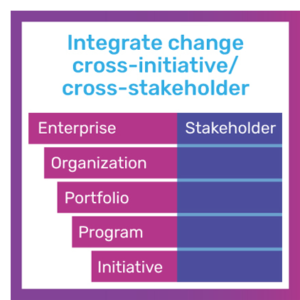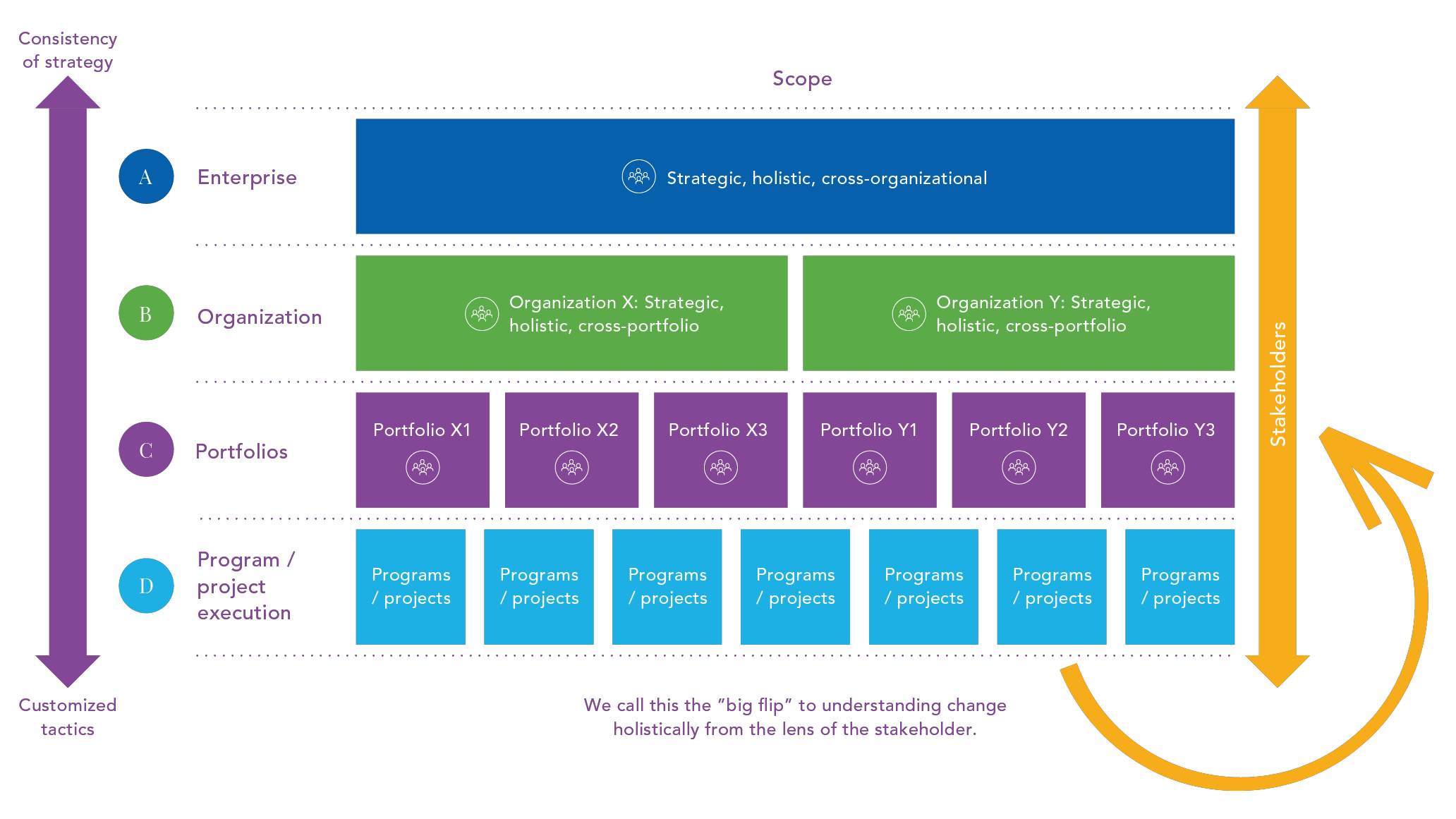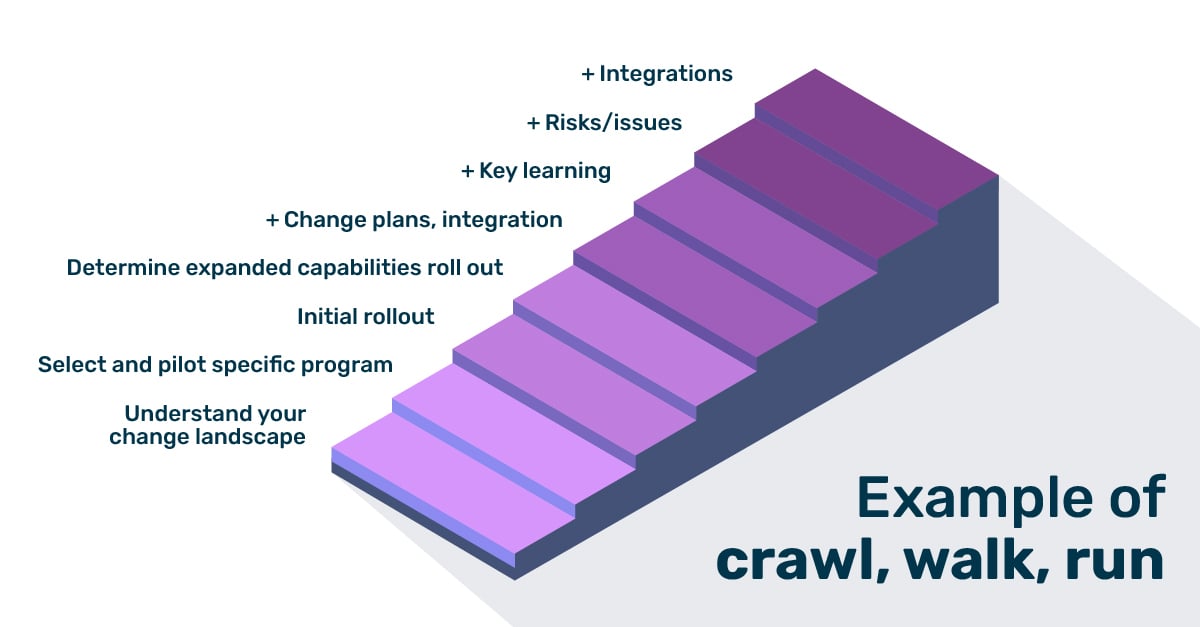It’s time to take an enterprise approach to change

Most of us want to make a difference and have a positive impact. It’s why we do the work we do.
But so much change is happening at an ever-increasing rate, it can feel like you’re just moving from one fire to another…
- Accelerated digital transformation

- Immersive customer experiences
- Competition for talent
- Skill gaps
- Employee and customer experience expectations
You already have change management handled… right?!?
Many organizations use change management tools and processes to improve outcomes for projects, programs, and business portfolios.
Some even take a broader approach with a Change Management Office (CMO) working in tandem with a Program Management Office (PMO) for specific programs and portfolios. And occasionally larger organizations use a Transformation Office (TMO) to tackle massive business shifts.
But most CM efforts don’t go far enough to connect the dots
Even with one or more of these approaches in place, how often do your projects compete for attention and resources? How many times does it seem like they’re working at cross-purposes? How thinly stretched are your change managers and stakeholders by being pulled in too many directions at once?
Here’s a familiar scenario:
There’s a constant stream of projects happening across multiple divisions. Several groups have change management teams aligned with PMOs, and there’s even a Transformation Office in place working on a major shift in strategic focus across the organization.
But there isn’t any real company-wide visibility to all of the change impacts and plans for projects that are simultaneously in flight, especially for those projects that touch more than one division. Each divisional leader has some visibility across their area of responsibility, but they use different tools to track and measure, making it difficult to get a clear overview. And nobody is talking about what stakeholders as a whole need or are experiencing as a result.
New projects are constantly starting up, pulling attention and resources from other projects. And it feels like each new project is starting from scratch to figure out when and how to best apply change management.
Somebody needs to do something!
All too often there’s no one armed with the right data and insights that the C-suite really needs to understand and manage the impacts of change across the entire enterprise. These conversations are crucial, but rarely happen. This is where Enterprise Change Management (ECM) can change the game.
How Enterprise Change Management works
Enterprise change management integrates change across functions, initiatives, and stakeholders. It applies proactive planning and aligned data to inform decisions and manage impacts more effectively. This enables you to drive visibility, consistency, and accountability in projects across the enterprise.
impacts more effectively. This enables you to drive visibility, consistency, and accountability in projects across the enterprise.
Adding software automation, you can more easily get the data views you need to understand impacts across the enterprise and highlight approaches that give people reasons to embrace and champion the changes that are most important to the business.
Enterprise Change Management (ECM) works “top-down” and “bottom-up”
From the top down, ECM allows you to elevate the conversation with business leaders – engaging, creating awareness and a sense of urgency, vetting, educating, and leading business transformation.
Leaders are able to see how projects support the overall company strategy, know what impacts and risks those changes will have on all stakeholders, and make more informed decisions about which projects to support, when to implement them, and what resources will be needed for the most successful outcomes.
From the bottom up, ECM starts with stakeholders in mind. It allows you to understand the collective impacts of projects across the enterprise, reinforce what’s in it for them, and clarify their contributions to greater goals.
When their needs are accounted for, stakeholders become champions for change and transform the business with proactive engagement.

Related reading: 13 ways technology enables people-first change orchestration
What ECM can do for you
Imagine for a moment…
You’ve made the case and have support for implementing Enterprise Change Management.
After gathering even just high-level information on all of the in-process and proposed projects across the organization, it becomes apparent that several projects have overlaps in deployment timing that will distract Sales teams with training, affect the Finance team’s year-end close activities, and overwhelm change management resources.
You have data that shows these conflicts and risks clearly. You facilitate conversations with business leaders using dynamic visualizations to dive deeper for detail and offering insights across all major projects, programs, and portfolios.
You can explain the overall impacts on employees, managers, suppliers, and customers and their experiences so that your plans to help people be ready, willing and capable to adopt the changes are optimized for the best business outcomes
For the first time, you’re able to make the value of change management visible and relevant to all of your organization’s top leaders – connecting the dots to help them make better, more informed decisions. You’re able to bridge the gap between “Can we do it?” and “We can do it and here’s how!”

Enterprise Change management is a journey where you set the vision and chart your course. The example above shows one approach where you start with understanding your holistic change landscape to determine what to pilot so that you can chart your initial course.
Remember to listen, learn and adapt on your journey to drive continuous improvement and increase value.
Get the guide: download our 21-page guidebook on orchestrating strategic change
Conclusion
In short, by elevating your change management to the enterprise level, you will be able to:
- Drive change that puts the stakeholder at the heart of change for transformational programs, taking a user experience-centered approach throughout the portfolio/program lifecycle.
- Orchestrate change holistically across impacted stakeholder groups at a program and portfolio level to manage priorities, impacts, and saturation.
- Ensure key behavioral changes that drive targeted business outcomes are defined and tracked as leading indicators to deliver ROI.
- Inform advanced decision-making to manage holistic change at stakeholder & organizational levels, using intelligent, cloud-based change management automation.
- Promote a culture across transformational operations that focuses on driving change with the stakeholder at the onset and throughout the lifecycle of the program.
Contact us at change@italentdigital.com for more information on how you can seed an enterprise-wide ability to flex with change to deliver critical gains across your organization.
You may also like:
How to use data to build a business case for change management
3 things successful change leaders do
Why and how to add change management to your project management approach



